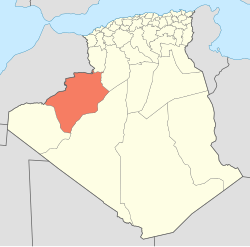| Béchar Province ولاية بشار | |
|---|---|
| — Province — | |
| Map of Algeria highlighting Béchar | |
| Coordinates: 31°37′N 2°13′WCoordinates: 31°37′N 2°13′W | |
| Country | |
| Capital | Béchar |
| Government | |
| • PPA president | |
| • Wāli | Mr. Mecheri Azzedine |
| Area | |
| • Total | 161,400 km2 (62,300 sq mi) |
| Population (2008)[1] | |
| • Total | 274,866 |
| • Density | 1.7/km2 (4.4/sq mi) |
| Time zone | CET (UTC+01) |
| Area Code | +213 (0) 29 |
| ISO 3166 code | DZ-08 |
| Districts | 12 |
| Municipalities | 21 |
Béchar (Arabic: ولاية بشار, Tifinagh: is a province (wilaya) inAlgeria, named after its capital Béchar.
The greater part of the province is uninhabitable sand dune fields (ergs), in particular the Great Western Erg and theErg Er Raoui, or dry plains (hamadas) suitable for grazing but with insufficient surface water to support agriculture. Most settlement is therefore concentrated in oases along the Saouravalley and its tributaries. An aquifer under the Erg Er Raoui supports the main outlier, Tabelbala. Natural resources include coal deposits in the north around Bechar and Kenadsa andcopper in the south in Djebel Ben Tagine.[2]
The oases' traditional economic basis was agriculture, notably growing date palms and grain. The inhabitants of several oases, notably Igli, Ouakda,Lahmar and Boukais, speak Berberlanguages, while the rest speak Arabic; in one oasis, Tabelbala, a Songhay language, Korandje, continues to be spoken. Many of the oases had significant populations of haratin orshurfa. There are notable zaouias, traditional religious schools, at Kenadsaand Kerzaz. The region also supported a substantial mainly Arab pastoralistnomadic population, notably the Doui-Menia, Ouled Djerir, Ghenanma,Chaamba, and Reguibat; some of these still remain nomadic, but most have settled in the oases.
Trans-Saharan trade routes passing through this region played an important role in its economy in pre-modern times, but have at present been superseded. A small tourism industry exists, focused particularly on Taghit. Bechar, whose growth from a minor village began only in the early 20th century, has become the principal urban and administrative centre.
The region has a distinctive musical scene influenced by sub-Saharan African rhythms, whose best known representative is the Gnawi singer Hasna El Becharia. Another locally well-known group is El Sed, from Kenadsa.



No comments:
Post a Comment